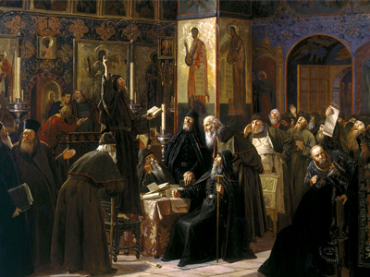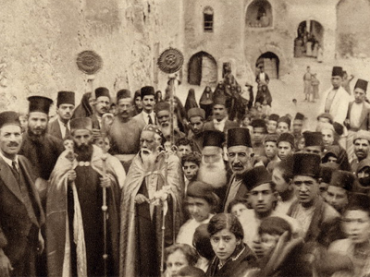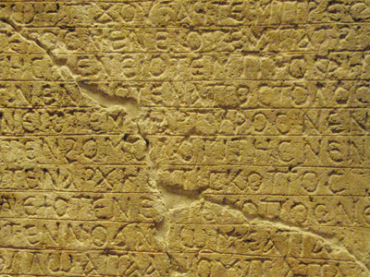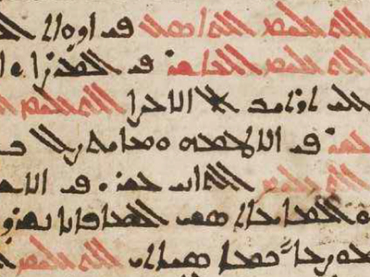Syriac and Eastern Christianity
Griechische Philosophen und ihre Lehren in syrischer Ueberlieferung
Abschnitte aus Theodoros' bar Kônî "Buch der Scholien"
Translation and Introduction by Anton Baumstark
Series: Analecta Gorgiana 421
ISBN: 978-1-60724-712-8
Anton Baumstark publishes here the portion of Theodore bar Koni’s Scholia that deals with the various Greek philosophical schools of thought. Baumstark provides an introduction to the Syriac text and includes a Latin translation.
$37.00
Die syrische "Liturgie" des Kyriakos von Antiocheia
Edited with an Introduction by Karl Kaiser
Series: Analecta Gorgiana 422
ISBN: 978-1-60724-713-5
Kyriakos, Patriarch of Antioch, was an influential figure in the development of the Syriac Monophysite tradition. Karl Kaiser presents here a brief but important survey of his life and publishes the Syriac text of a liturgy attributed to Kyriakos.
$35.00
Eine arabische Palästinabeschreibung spätestens des 16. Jahrhunderts
Translation and Introduction by Anton Baumstark
Series: Analecta Gorgiana 423
ISBN: 978-1-60724-714-2
Descriptions of the Holy Lands abound, yet each offers a unique perspective. Anton Baumstark publishes here an Arabic version of one such description accompanied by a brief introduction to the text and a Latin translation.
$44.00
Der Nomokanon Miha'ils von Malig
Translation and Introduction by Franz Cöln
Series: Analecta Gorgiana 424
ISBN: 978-1-60724-715-9
The Nomocanons of the Eastern Orthodox traditions are valuable historical sources for the church traditions they represent. Franz Cöln presents here the collated text of a Nomocanon attributed to Miha’il of Malig and preserved in Garshuni and Arabic manuscripts.
$133.00
Alfabetische Akrosticha in der syrischen Kirchenpoesie
Translation and Introduction by Bruno Kirschner
Series: Analecta Gorgiana 425
ISBN: 978-1-60724-716-6
Bruno Kirschner publishes here the Syriac text of seven full acrostic Sogiatha hymns and accompanies each with a brief introduction and a German translation. Kirschner also includes a general introduction to acrostic poetry in the Syriac tradition.
$56.00
Salvation in Christ According to Jacob of Serugh
An Exegetico-theological Study on the Homilies of Jacob of Serugh on the Feasts of Our Lord
ISBN: 978-1-60724-880-4
Jacob of Serugh’s vision of ‘Salvation in Christ’, in its exegetical, theological, catechetical, liturgical and pastoral aspects, is reviewed in this monograph. Jacob’s mode of symbolic-mystical-silence approach to the mystery of Christ is explained. This treatise gathers up Jacob’s typological and symbolic thought-patterns, in his own language, categories, terminologies, and imageries.
$220.00
Die Heiligtümer des byzantinischen Jerusalem nach einer übersehen Urkunde
Series: Analecta Gorgiana 426
ISBN: 978-1-60724-732-6
Anton Baumstark compares the description of various holy sites in Jerusalem from the Byzantine age in a neglected source—a tenth-century Typikon of Anastasis—with the descriptions found in other ancient texts.
$44.00
Ein byzantinischer Buchschmuck des Praxapostolos und seine syro-palästinensische Vorlage
Series: Analecta Gorgiana 427
ISBN: 978-1-60724-733-3
Illustrations were common in manuscripts of the Gospels, but far less common for the Acts and Epistles. Anton Baumstark describes the images found in one manuscript that does include illustrations for these documents and compares them with the Eastern tradition.
$36.00
Koptische Poesie des 10. Jahrhunderts
Translation and Introduction by Hermann Junker
Series: Analecta Gorgiana 428
ISBN: 978-1-60724-734-0
Hermann Junker provides here a thorough discussion of the salient features of the Coptic poetry that flourished in the tenth-century. Following this introduction, Junker provides the Coptic text and German translation of dozens of these poems.
$108.00
Une autobiographie syriaque de Denys l'Aréopagite
Translation and Introduction by Marc-Antoine Kugener
Series: Analecta Gorgiana 429
ISBN: 978-1-60724-735-7
The “Autobiography” of Dionysius the (Pseudo-)Aereopagite exists in two separate recensions found in three manuscripts. Marc-Antoine Kugener publishes here the Syriac text of the two recensions along with an introduction and a German translation.
$43.00
Das Alter der Peregrinatio Aetheriae
Series: Analecta Gorgiana 430
ISBN: 978-1-60724-736-4
Anton Baumstark discusses the critical issues in the dating of the text of the Peregrinatio of Egeria. After comparing the account with other texts, Baumstark concludes in favor of the traditional fourth-century date and provides needed support for this conclusion.
$41.00
Eines Anonymus' Abhandlung über Feste und Fasten, Autorität und Gehorsam in der syrischen Kirche
Translation and Introduction by Franz Cöln
Series: Analecta Gorgiana 431
ISBN: 978-1-60724-737-1
Franz Cöln publishes here an anonymous treatise that deals with the topic of church authority from the perspective of the Syriac tradition. Cöln publishes the Arabic text of the treatise and includes a Latin translation and a brief introduction.
$41.00
Vier geistliche Gedichte in syrischer und neusyrischer Sprache
aus den Berliner Handschriften Sachau 188 und 223 übersetzt und mit Einleitung versehen
Translation and Introduction by Bernhard Vandenhoff
Series: Analecta Gorgiana 432
ISBN: 978-1-60724-738-8
Bernhard Vandenhoff publishes here a German translation of three Neo-Aramaic poems and one Syriac poem. In the introduction to these translations, Vanderhoff discusses the dialects and provides an overview of the content of the poems.
$45.00
Die Panoplia dogmatica des Euthymios Zigabenos
Untersuchung ihrer Anlage und ihrer Quellen, ihres Inhaltes und ihrer Bedeutung
Series: Analecta Gorgiana 433
ISBN: 978-1-60724-739-5
Jacob Wickert offers one of the most thorough discussions of Euthymios Zigabenus ever produced, including an introduction to his life and a detailed discussion of the contents of Euthymios’s compendium of heresies, the Panoplia Dogmatica.
$56.00
Un chapiteau et une imposte provenants d'une ville morte
Etude sur l'origine et l'époque des chapiteaux-corbeille
Series: Analecta Gorgiana 434
ISBN: 978-1-60724-771-5
Wladimir de Grüneisen surveys the history of the basket-design in art and architecture in the Greco-Roman world based on a column capital and transom discovered at Tusculum.
$40.00
Neue griechisch-saïdische Evangelienfragmente
Edited with an Introduction by Joseph Heer
Series: Analecta Gorgiana 435
ISBN: 978-1-60724-772-2
Joseph Michael Heer discusses the philological, text-critical, and liturgical value of five parchment pages containing the resurrection narratives from the Gospels of Mark and Luke in parallel columns of Greek and Sahidic Coptic and provides a transcription of the texts.
$41.00
Der Drachenkampf des heiligen Theodor
Edited with an Introduction by Willy Hengstenberg
Series: Analecta Gorgiana 436
ISBN: 978-1-60724-773-9
The ancient myth of a hero who slays a mythical beast worked its way into the lore of early Christianity. Willy Hengstenberg discusses here the sources for the dragon-slaying legend attributed to two separate fourth-century figures named Theodore.
$46.00
Une lettre de Sévère d'Antioche à la diaconesse Anastasie
Translation and Introduction by Marius Chaîne
Series: Analecta Gorgiana 437
ISBN: 978-1-60724-774-6
Marius Chaîne publishes the Coptic text and French translation of a letter attributed to Severus of Antioch and addressed to the deaconess Anastasia. In the introduction, Chaîne discusses the attribution to Severus and the exegetical method displayed within the letter.
$37.00
L'Octoëchos Syrien
Series: Analecta Gorgiana 438
ISBN: 978-1-60724-775-3
Oriental liturgical experts Jules Jeannin and Julien Puyade survey the historical development and musical features of the Greek Octoechos musical tradition as it was adopted, adapted, and utilized in the Syriac tradition.
$41.00
Ein Brief des Elias bar Sinaja über die Wahl des Katholikos Iso'jahb IV
Translation and Introduction by Bernhard Vandenhoff
Series: Analecta Gorgiana 439
ISBN: 978-1-60724-776-0
Bernhard Vandenhoff publishes here a German translation of the letter of Elias bar Shenaya in which he publicly denounces the election of Catholicos Isho’yahb IV. In the introduction, Vandenhoff also briefly describes the historical circumstances that produced the letter.
$41.00
Untersuchungen zur syrischen Überlieferung der Siebenschläferlegende und Die älteste Gestalt der Sie
Edited and Translated by Arthur Allgeier
Series: Analecta Gorgiana 440
ISBN: 978-1-60724-777-7
Arthur Allgeier publishes here two articles concerning the “Legend of the Seven Sleepers” in the Syriac tradition. The first article includes a discussion of the text’s transmission history and the second includes the Syriac text, German translation, and apparatus.
$72.00
Die Anaphora des hl. Jakobus, des Bruders der Herrn
Nach dem Ms. aeth. 74 der Bibliothèque zu Paris
Edited and Translated by Sebastian Euringer
Series: Analecta Gorgiana 441
ISBN: 978-1-60724-778-4
Sebastian Euringer publishes here the Ethiopic text and German translation of an anaphora attributed to James, the brother of Jesus.
$36.00
Iulianos der Abtruennige
Syrische Erzaehlungen
Edited by Johann G. E. Hoffmann
Series: Syriac Studies Library 13
ISBN: 978-1-60724-794-4
This work contains two Syriac texts bearing on the (in)famous Julian the Apostate, both in terms of history and religion. The book includes a critical apparatus to the Syriac texts and indices of proper names and Greek words.
$178.00
Supplement to the Thesaurus Syriacus of R. Payne Smith
Compiled by Jesse Payne Margoliouth
Series: Syriac Studies Library 14
ISBN: 978-1-60724-795-1
Jessie Payne Margoliouth here continues the work of her father’s Thesaurus Syriacus, including new words and meanings that had been discovered after publication of the Thesaurus. The Supplement gives definitions in English (not Latin).
$196.00
Die syrischen Kanones der Synoden von Nicaea bis Chalcedon nebst einigen zugehörigen Dokumenten
Edited with an Introduction by Friedrich Schulthess
Series: Syriac Studies Library 17
ISBN: 978-1-60724-813-2
This work contains the Syriac texts of the canons of church councils/synods from the fourth and fifth centuries. After a brief introduction, Schulthess presents the Syriac texts with a small number of critical notes.
$170.00
Filter by
Filter by price
Filter by manufacturer































